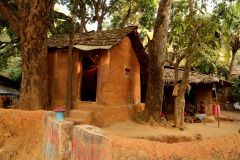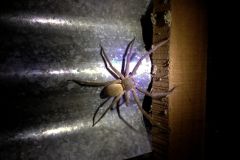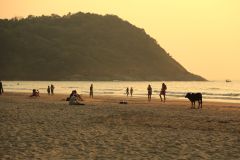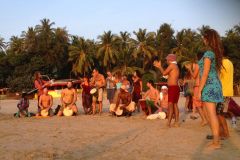Tropical coma in Gokarna
Peaceful Gokarna, Bhagavatgita revisited, mud hut with tarantulas, killing madness and bit of Marco Polo
They say that Gokarna is what Goa used to be 15-20 years ago. I don’t know if it’s true, because obviously I haven’t been to Goa 15-20 years ago, but it surely is much more relaxed and authentic. There’s still a lot of backpackers and healthy hippie-yoga crowd, but much fewer Russians and no party-goers at all. The beach is nice, the beach restaurants are there as well, drummers drum at sunset, but the accommodation is as simple as it gets, which I guess keeps most of the mainstream tourists away. Plus there is no road to the beach, where all the goodness is, so you have to walk at least 15 minutes down a cliff pathway to reach it. Maybe it also helps to keep some people away. Absolutely nothing happened in Gokarna, or more precisely Kudle Beach, where we stayed, except a short but intensive eruption of killing madness. Relax, we are talking about insect here.
In Gokarna pretty much all accommodation are simple, very simple huts made of coconut leafs, without any floor or windows, plus ages old houses made of mud/cow dung (i.e. adobe). When we saw the adobe houses we fell in love with them. They look like brough straight from Africa! So cool! We chose a hut located bit off the beach, in a family place, in something like a homestay. A small herd of cows, family kids and monkeys were all around all the time and the place had fantastic atmosphere, although the accommodation standard was that of year 1 AD :-) The only problem was, that living in an old house, with its roof not really attached to the walls, in the tropics, means a lots of crawling friends. A giant something-like-cockroach which kept on returning was disgusting enough, but a giant spider, on par with Australia’s Huntsmen spider was really something special. BIG, meaty, hairy spider, which looks like small tarantula. Irene almost collapsed when she saw it :-) Ugh! So massive, the 8-legged fucker! First night we chased it away (ehm, a local granddaddy chased it away, after telling us that it’s not poisonous), but on the second night, I decided to let it move on in its samsara cycle and I smashed it with my shoe… Only to discover another fucker hiding behind my bag. Well, another one bites the dust! The third spider was not threatening at all, but being in the killing mood I ended his misery as well. If killing a spider brings 7 years of bad luck (as we say in Slovakia), I just accumulated 21 years of it. I had mercy with a giant centipede (could be that it was actually much more dangerous than the spiders) and just threw it out, and as a final piece of insect genocide I decided to end a battle of a giant black ant (2,5 cm long, I’m not kidding you!) with a giant red ant (2 cm long), who were dueling right on our bed, with a fair tie – they both died. Well, the red one was already half-killed by the black one anyway. They sure bite like hyenas! And thus, in rage of blood thirstiness I cleared our house of all the invaders and re-claimed our territory. I do regret their deaths, but as Bhagavatgita informed me, passing of themortal body can never destroy the deathless soul, so I know they will go on, somewhere else. They just shouldn’t have fucked around!!!
Oh, speaking of Bhagavatgita, during those 2 days in Gokarna I’ve read it again, already for the third time. And so, Bhagavatgita joined Herman Hesse’s Siddhartha as my most read book. Krishna, thank you for disclosing the Most Secret of Information to us, the mere mortals (mortal at least on bodily level). Om Tat Sat.
Apart from Bhagavatgita, I have also finished reading Marco Polo’s Travels (yes, finally, more than 1,5 years since I had bought it in Noosa, the day I lost my camera in Australia), and I found few interesting sentences on India to share. Remember, this is all from the end of 13th century:
Let me tell you further that they daub all their houses with cow-dung.
Hmm, Marco just proved my assumption about our house :-)
When they are drinking, they do not set the flask to their lips, but hold it above and pour the fluid into their mouth.
Interesting. Because they still do it this way. I thought that it was a modern “invention” due to discovery of existence of viruses and bacteria and attempt to prevent its spreading by using common glasses in restaurants, but obviously it is not so.
Again, their houses are infested with certain animals called tarantulas, which run up the walls like lizards. They have a poisonous bite and do serious harm to a man if they bite him.
AHA!
Well, all the same 600 years later…
They are all black-skinned and go stark naked, both males and females, except for gay loin-cloths covering their private parts.
Well, looking at the granddaddy from our “guesthouse”, again: all the same 600 years later. I especially love the term “gay loin-cloths”. I couldn’t have described it better in 2015 :-D
These Brahmans live longer than anyone else in the world. This is due to their light feeding and great abstinence.
Write this one down and act accordingly.
And then he provides some more of deep truths about India, such as that they use their kids for conducting business and the kids are running around whole day asking people if they wanna buy this or that, how they shit into the ocean (presumably to avoid worms to emerge from their shits, which would inevitably later die and thus their shit would cause a great loss of lives if they didn’t wash it into the ocean) and how holy men go around with naked dicks, because since they do not commit any sins with their dicks, their dicks are pure and there is no reason to cover them any more than one would cover his hand or face.
Amazing how much of that what was going on in 1280 is still going on in 2015 in India!



